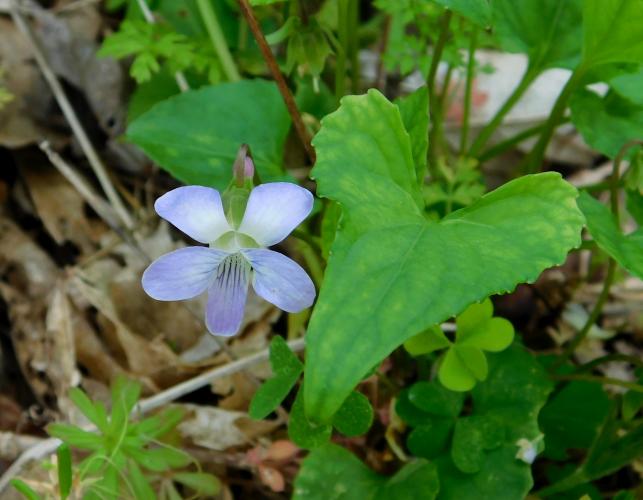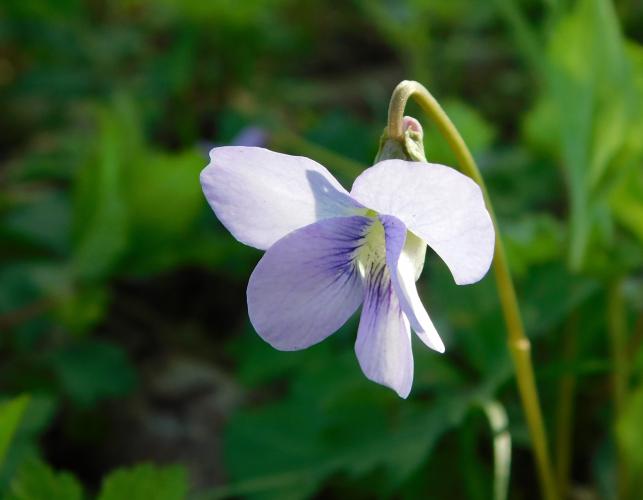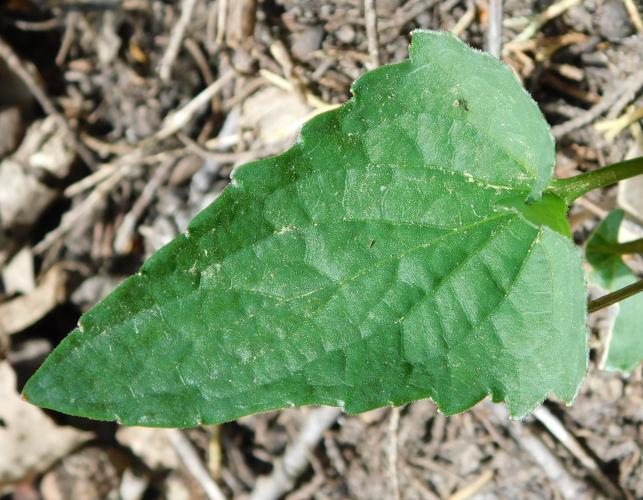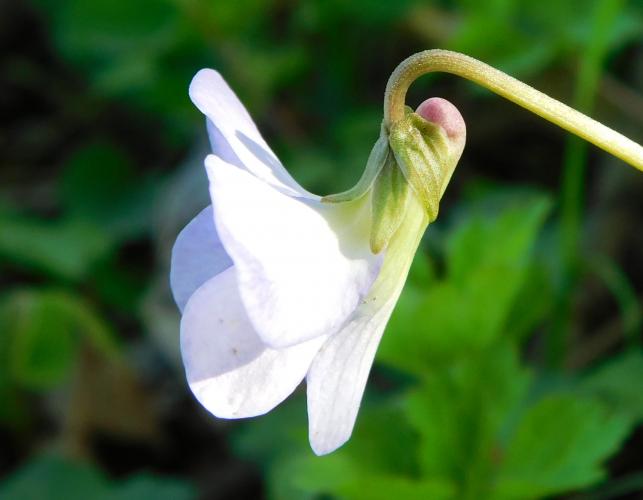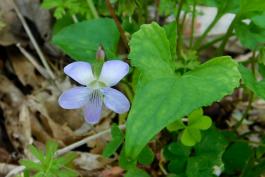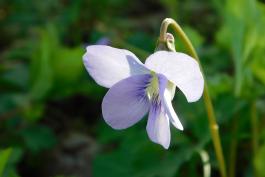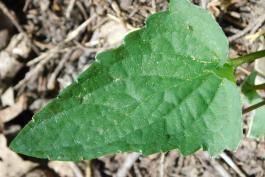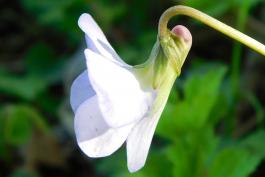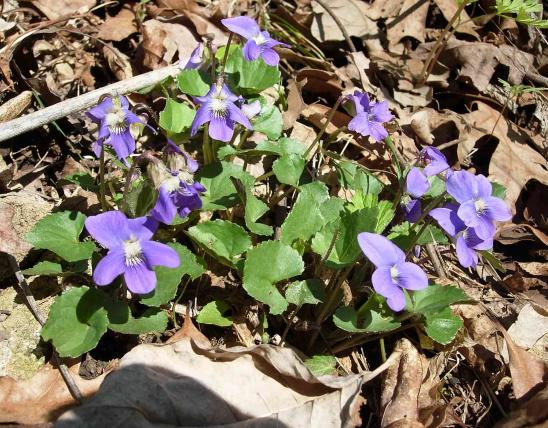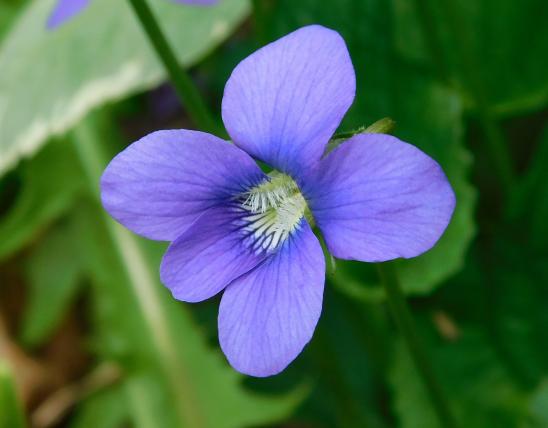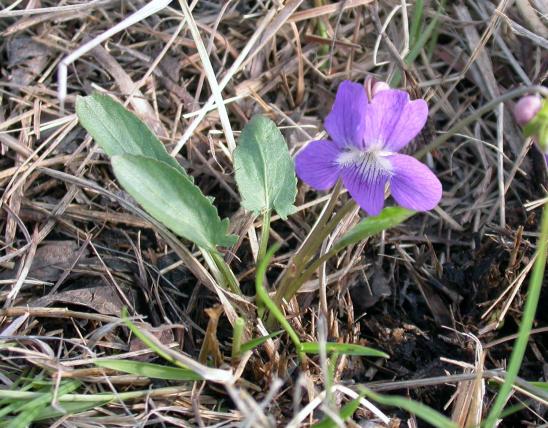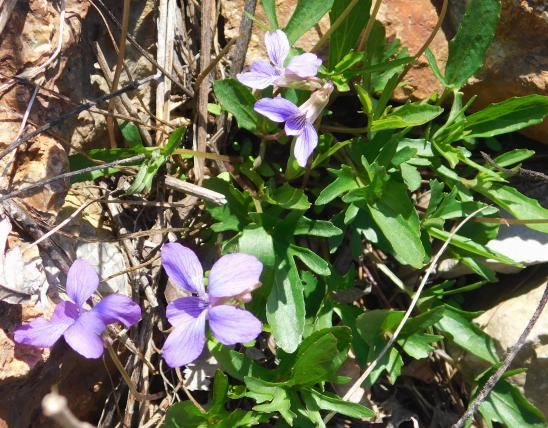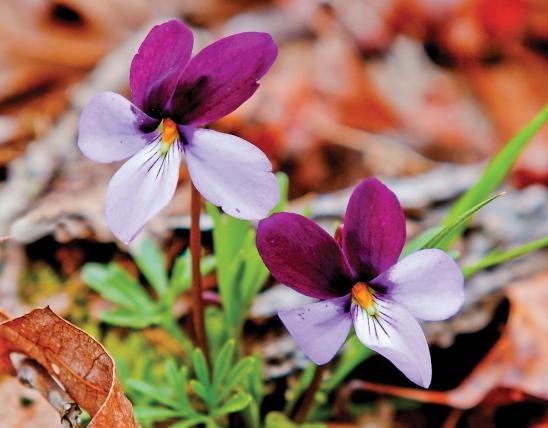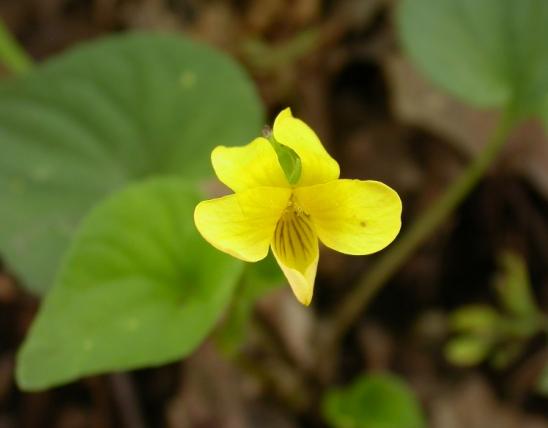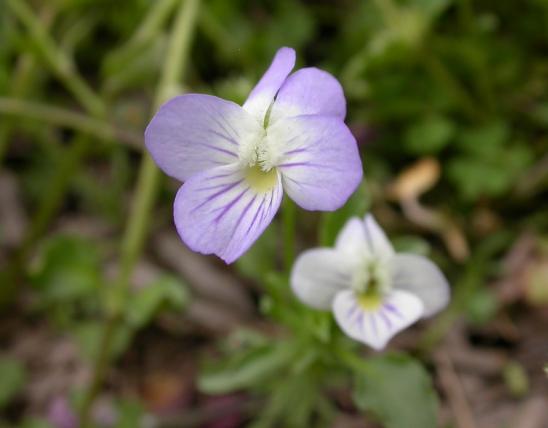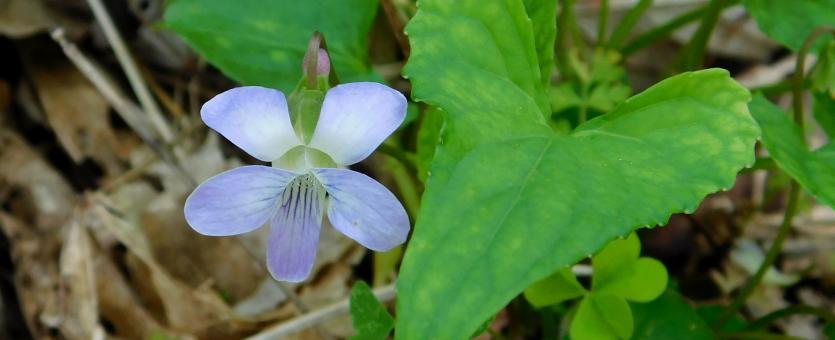
Missouri violet is one of five Missouri native, perennial, stemless violets with purple or blue flowers and unlobed leaves. It is best distinguished from the others by its triangular or heart-shaped leaves that are longer than wide and are coarsely toothed only on the basal two-thirds.
The flowers closely resemble those of our other four stemless blue/purple violets with rounded or heart-shaped leaves, though in Missouri violet, the hue typically is more lilac, slightly paler, and there is often a darker purplish area surrounding the whitish-green throat, looking a little like an eyespot. Like many of our state’s violets, there are usually darker veins on the petals. Blooms March–May. Note that other violet species, especially common violet (V. sororia), can occur in a wide range of flower colors, including varying shades of purple, meaning that flower color alone is imperfect for making IDs.
The leaves in Missouri violet are distinctive. The leaf blades are longer than wide, unlobed, narrowly triangular to ovate-triangular, truncate (evenly perpendicular to the stem) to shallowly cordate (heart-shaped) at the base, the margins relatively untoothed on the outer third of the blade; otherwise coarsely toothed.
To learn more about Missouri's violets (genus Viola) as a group, visit their group page.
Similar species: Missouri’s four other stemless blue/purple violets with unlobed leaves are described below, listed in order roughly by how common or widespread they are.
- Common violet (V. sororia). Native, perennial. Common statewide in a wide variety of natural habitats but also in yards, roadsides, and many other disturbed areas. It is often cultivated; some view it as a weed. It is variable in flower color, ranging from purple to pale bluish, to white, to white with purple spots or blotches. Foliage may be quite hairy to nearly hairless. Most times, when you see a purplish, stemless violet with round or heart-shaped leaves, this is the species you’re seeing.
- Blue prairie violet (V. nephrophylla, syn. V. pratincola). Native, perennial. Uncommon and widely scattered, mostly south of the Missouri River. Lives on banks of streams and rivers, fens, margins of ponds, and other seepy areas; also in mine tailings, lawns, railroads, and roadsides. It is very similar to V. sororia, but it has thicker leaves that are finely, evenly toothed; the early season leaves are smaller and oval, often purplish on the undersides; also, its cleistogamous (nonopening) fruits are uniformly green (not purplish mottled as is usual with V. sororia), on erect, ascending stalks. This species is widely distributed in North America and is especially well-known in the western United States.
- Marsh violet (V. cucullata). Native, perennial. Uncommon in the eastern half of the Ozarks and in nearby parts of the Ozark border. Lives in fens, acid seeps, and bases of bluffs. In this species, the flowers strongly overtop (rise above) the leaves. The flowers usually have a dark purple border next to the whitish floral throat, resembling an eyespot. The sepals are often noticeably 3-veined and uniformly tapering to very sharply pointed tips. The leaf blades are longer than wide and are ovate to heart-shaped, heart-shaped at the base, the margins finely toothed their entire length or they may be distinctly wider than to about as wide as long.
- Sand violet (V. affinis). Native, perennial. Uncommon, a Missouri species of conservation concern, ranked as critically imperiled; it was first documented in our state in 2009 in New Madrid County. Lives in swamps, bottomland forests, and shaded levees. It is similar to V. cucullata but is distinguished by having its open flowers about the same height as the leaves. Also, although its long-tapered leaf tips are similar to those of V. missouriensis, it can be distinguished from that species by its leaf blades being more deeply cordate at the base and more finely and regularly toothed along the margins.
Height: to about 16 inches.
Scattered to common nearly statewide.
Habitat and Conservation
Occurs mostly in moist or lowland habitats: bottomland forests, mesic upland forests, banks of streams and rivers, sloughs, margins of ponds, lakes, and sinkhole ponds, bottomland prairies, marshes; also ditches, fallow fields, lawns, railroads, roadsides, and disturbed areas.
Status
Native Missouri wildflower. Like several other violet species, it can be used in native wildflower gardening.
Botanists have debated the appropriate classification of this plant. Some consider it a variant of the common violet (V. sororia), and it is probably closely related to sand violet (V. affinis). Currently, most botanists seem content to consider Missouri violet as a truly distinct species.
Human Connections
Violets are a favorite sign of springtime in Missouri. They are enjoyed by native wildflower gardeners as blooming groundcovers or naturalized in woodland plantings or in rock gardens. Though rather small, they are gratifying to grow, since they are valuable to wildlife ranging from butterflies to the variety of birds and mammals that browse their leaves and fruit capsules. Get starts of these plants from reputable wildflower nurseries.
The attractive flowers of Missouri violet and other stemless blue-flowered violets are used to make a beautiful jelly. They can also be candied for unique confections and garnishes, and they can be eaten in salads (though the flavor is bland). The leaves also hold significant amounts of vitamin C and are edible as a nutritious potherb in spring. The young foliage of most stemless blue violets can be eaten raw or cooked, with a mucilaginous texture similar to that of okra. Throw some in with your other salad greens.
Missouri violet’s scientific and common names are equivalent. The species name, missouriensis, means “from Missouri.” By the way, the scientific journal of the Missouri Native Plant Society is named Missouriensis. If you are interested in learning about Missouri’s native plants, the Missouri Native Plant Society is a great group to join.
Violets have historical uses globally as medicinal plants, and modern researchers are investigating a wide array of potential pharmaceutical properties.
If you’re struggling to distinguish between the various stemless blue violets, don’t feel bad. As one Missouri botanist put it, the “taxonomy of the weedy blue violets affiliated with the V. sororia complex remains a tangled mess.”
Ecosystem Connections
Violets are the food plants for the caterpillars of several kinds of moths and butterflies, including some notable, nifty ones: the giant leopard moth, the regal fritillary, plus most other fritillary species, which are all colorful, medium-sized to large butterflies.
Pollination is carried out by various flies, bees, butterflies, and more.
Like many other perennial herbaceous wildflowers, Missouri’s violets help hold the soil, preventing erosion, and provide forage for many grazing animals ranging from rabbits and woodchucks to geese and deer. Many songbirds, rodents, and other animals eat the seeds.
This and many other violets produce nonopening, cleistogamous flowers, which typically grow below the leaves, close to the ground. These begin to form later in the spring and summer and are a strategy that helps these rather small wildflowers to reproduce even when larger plants start to cover them, making them more difficult for pollinators to find.
Seed dispersal in violets occurs in two ways. The first is a a forceful, mechanical ejection as the fruit dries and pops open. The second involves myrmecochory (mur-muh-co-cory). In this process, the seeds are carried away to new locations by ants. Violet seeds have a special nutrient-rich structure on the outer surface called an elaiosome (ell-eye-uh-soam), which ants find delicious. The ants carry the seeds into their nests and eat the elaiosomes or feed them to their young. The ants then move the uneaten, still fertile portions of the seeds to their nest’s waste-disposal area, where the seeds can germinate in a cozy, protected, nutrient-rich environment.
